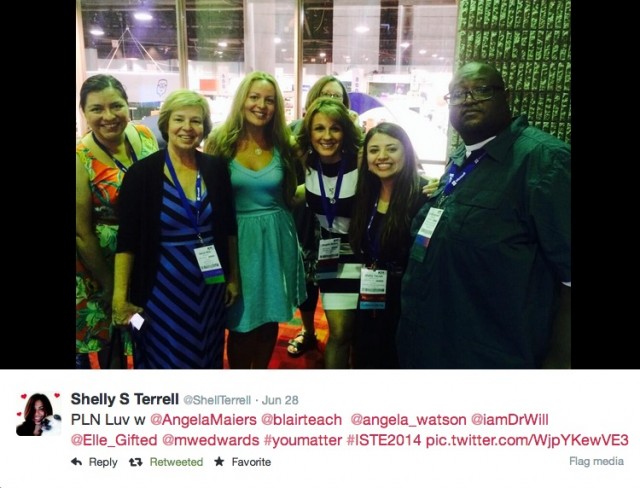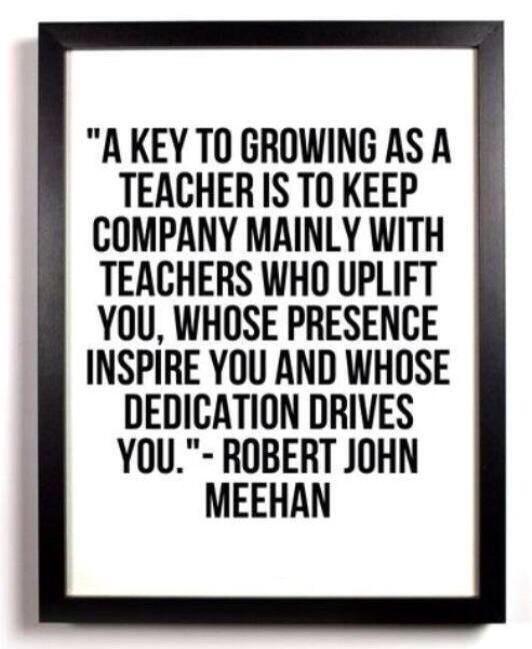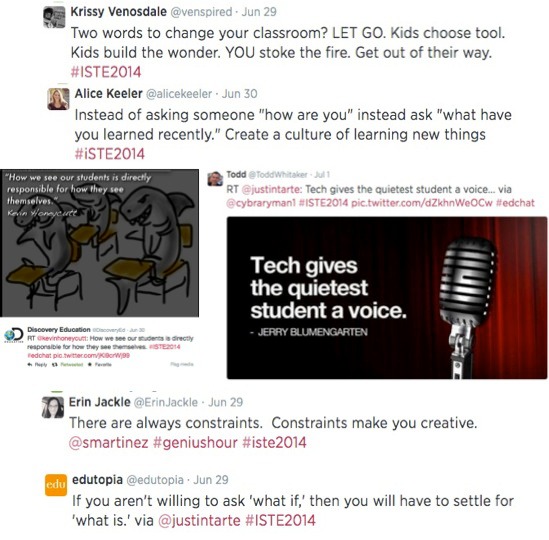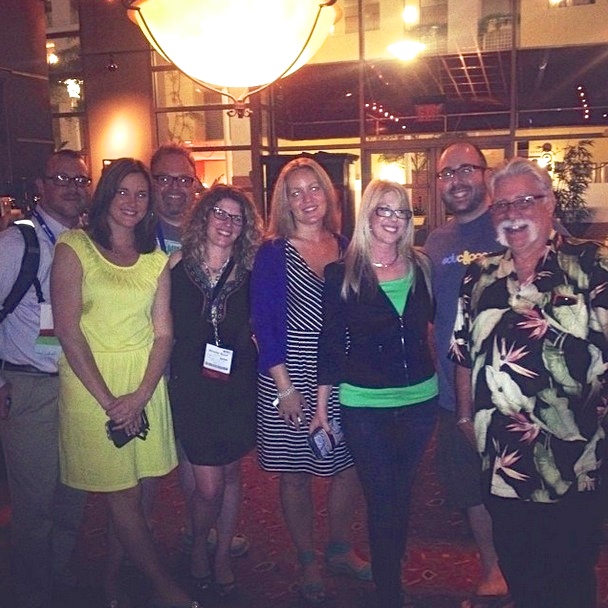I’ve always thought the term “re-entry” to our regular lives after an ISTE conference was a bit dramatic, but it really does feel that way this year. 16,000 educators in one building is…intense. Now that I’m back from Atlanta and scrolling through my notes, I’m going to try to condense everything down to 10 main take-aways. These are not necessarily the most emphasized or important ideas shared, just the “aha moments” that stuck with me most deeply this year:

1) Last year our discussions emphasized getting kids engaged in learning; this year, the conversation shifted to teaching kids how to learn for themselves.
Many innovative educators spent the past year experimenting with giving students more control than ever over their learning…and it didn’t always go smoothly. I’ll be blogging about this in depth soon, but essentially, many kids are uncomfortable or unsuccessful with student-directed projects because they haven’t yet learned the strategies they need to take charge of their learning. There are skills we need to explicitly teach so that kids understand how to discover their passions, ask good questions, and effectively find ways to answer those questions.
2) Relationships with students are crucial, but we have to be careful not to take that to an illogical extreme.
I disagree with the idea floating around on Twitter that relationships are the end goal of teaching and content is just the method for building relationships. In fact, I would argue for the opposite: student learning is the end goal of teaching, and relationships are the method we use for helping kids learn. The very discussion of this topic is an #isteproblem, of course, considering that most school districts aren’t emphasizing teacher-student connections on any level and instead are focused completely on test scores. I think we all need to reflect on how to strike the right balance in our schools between guiding students to meet learning standards and also prioritizing relationships as we celebrate kids as individuals who learn best when they feel a connection with us.

3) When you give someone responsibility, you must also give them some measure of authority.
This doesn’t always happen to teachers: we are responsible for student’s test scores, but have no authority over whether students come to school on time, eat balanced meals, get proper sleep, have functional home and social lives, etc. The imbalance causes tremendous frustration…but how often do we do the same thing to our students? We give them so much responsibility (do this assignment, turn this in, behave this way, complete this project) but we often give them little authority over how the classroom is run. If we see that kids are frustrated, we need to try giving them a greater authority to make decisions and direct the course of their learning.
4) Everyone has trouble staying disciplined and motivated with work.
I always assume that I am particularly distractible and other people are accomplishing more than me. Then I had a wonderful brunch with two edupreneurs I really admire and the three of us all admitted that we have a really tough time buckling down when we work from home. It takes tremendous drive and self-motivation to run your own business, and if you don’t set a work schedule and stick to it, you either won’t get things done or work will consume your life. It’s a tough balance but it was so reassuring for me to hear that I’m not the only one struggling.

5) We NEED to surround ourselves with inspiring and encouraging educators.
There are too many negative voices out there, and if we don’t seek out the people who inspire us, we won’t be able to maintain our enthusiasm. This is not an optional part of being an educator and it can’t be ignored: if we aren’t learning together and supporting one another, burnout inevitably sets in. Going to ISTE is obviously a great way to connect with inspiring educators and it’s my #1 reason for attending, but an uplifting experience once a year at a conference is not enough. We have to continue to seek out encouraging people online afterwards and build communities of positive educators in our schools.
6) In order for kids to stay motivated, they need to be around inspiring people, too.
Lately I’ve been thinking a lot about how my passion for my work ebbs and flows based on the influences I choose to fill my time with: listening to BAM Radio or an Entrepreneur on Fire podcast motivates me to create and achieve; watching Real Housewives drains my energy. But as I talked with Angela Maiers and Steve Hargadon at the Hack Education party and learned more about how they are connecting kids with role models, I started thinking more about how kids need to be around inspiring people, too. They need to have connections with adults they look up to and people from the field they want to one day enter, as well as connections with other students who are achieving similar goals and can encourage them. We always talk about kids being influenced by their peer group and the issues of peer pressure, but I’m now considering the issue from the angle of inspiration, not influence. Kids need to be around people who inspire them to do better. What can I do to support them in that?

7) You do not have to be an extrovert to be effective in our field.
I talked with a lot of incredible people this weekend about introversion vs. extroversion, and nearly all of them identified as introverts. You might see them flitting about, chatting, laughing, and talking, but that doesn’t mean that all of that comes naturally to them. It also doesn’t mean that if you approach someone you met on Twitter and they aren’t jumping up and down with enthusiasm that they’re snubbing you. They might just be introverts who are overwhelmed by the crowds, noise, and need to be “on” for so many hours at a time. This was a significant realization for me personally, as I always assumed that socializing and networking came naturally to everyone else at ISTE and that I was the only one who desperately needed time alone to recharge and reflect.
8) Educators cannot be afraid to put ourselves out there and promote what we’re doing.
This is something I’ve been reflecting on a lot lately and it was confirmed in a number of conversations ISTE. For example, two of my books hit the top 5 in their category on Kindle last week. I took a screenshot because I thought it was so cool to be ranked alongside the Daily 5 and The Book Whisperer…but I didn’t want to tell anyone because I was afraid of being perceived as arrogant or braggy. I pushed myself in this area and told my friends on Instagram as well as my personal Facebook (thought I didn’t have the nerve to post it to my public FB page). And guess what—people were excited for me, and proud of me. So, lesson learned: I need to share the cool stuff that’s happening! Similarly, teachers don’t often share the incredible work they’re doing in their classroom, and many of them assume what they’re doing isn’t all that great. But the truth is that everyone has experiences and ideas that can benefit others—you never know who you might be able to help! We ALL need to celebrate our accomplishments, share them with others, and graciously accept compliments without diminishing ourselves (thanks, John Spencer, for that last concept.)

9) Innovation is only possible when we are willing to give up control.
Eric Sheninger mentioned this is relation to tech integration: if we insist on being the sole bearers of knowledge in our classrooms and completely directing students’ learning, we will never innovate. We have to trust our students and become learners alongside them. We have to stop dictating what kids learn and how, and allow them to have a voice in what happens in the classroom. The only way to create change is by stepping out of our comfort zones.
10) Innovation is a marathon, not a race.
That’s based on a conversation with Nick Provenzano that got retweeted a million times, for good reason. We can’t expect ed reformation or better yet, transformation, to happen overnight. The trends that are talked about at ISTE this year (such as the maker movement and augmented reality) were informally explored in innovative classrooms this past year: they’ll be piloted in more classrooms next year, receive grant money for larger scale implementation the following year, become a popular PD topic three years from now, and become more common classroom practice four years from now…long after better tools and pedagogical practices have been discovered. That’s okay. We’re running a marathon here. We’re in this for the long haul. There will be some failure along the way, and that’s okay, too. We have to be steadfast in our mindset that we will keep pursuing understanding of what is best for kids.
If you weren’t at the conference, I’d love to hear your thoughts on what I’ve shared here. And if you did attend, please feel free to leave your reflections (or a link to a post with your reflections) in the comments. Thank you for sharing!
Previous ISTE reflections:

Angela Watson
Founder and Writer
Sign up to get new Truth for Teachers articles in your inbox
Discussion
Leave a Reply
OR

Join our
community
of educators
If you are a teacher who is interested in contributing to the Truth for Teachers website, please click here for more information.
















Thank you for sharing! #5 & #6 resonated with me the most. In our current climate surrounding ourselves with like minded people is almost a survival skill. Another reason why I love PLNs!
Great post. My favorite tips were 7 and 8. 7 shows why an online presence is so helpful to introverts…it really gives us a voice. 8 has become my mission, and my biggest take-away from a journey to connectivity. Thank you so much for sharing your reflections.
Cheers,
Sarah
Sarahdateechur.com
Sarahjanethomas.com
Excellent summary of your week! I was following many of the attendees on Twitter, and I could tell from my remote spot that it had to be an intense experience! Thanks for taking the time to give us your overview. No surprises certainly, but all are great reminders to us as we head back in the fall.
I have a personal connection to #8. I work for Pinal County as the secondary educational specialist. I have been in this position for almost 1 year. One thing that I would really like to see more teachers in our county to do is connect through Twitter. We are a large county and some of our schools are geographically isolated. I really think an easy way for them to collaborate is through Twitter, Blogging, etc. I have a Twitter account (@kcota15) and have started a blog (http://kcota15.blogspot.com/) that I need to be more active on. As of yet, even though I advertise to every teacher I work with, I only have 2 teachers in the county that follow me via Twitter. I share lots of great stuff and just wish they would jump on the Twitter train. Not sure how to do this yet, but I have challenged myself to share more through social media, even when I think what I have to say isn’t that important or inspiring.
I will get more teachers involved in using social media to create a PLN! If you have ideas to help, please send them my way.
Hi Angela
Thanks for sharing. After reading about your thoughts and experiences when I looked at your profile, I surprised to know that you were a teacher. I don’t know how long have you left your classroom teaching, but I am sure that hypothetically you remains in your classroom. Your reflection is an evidence of it.